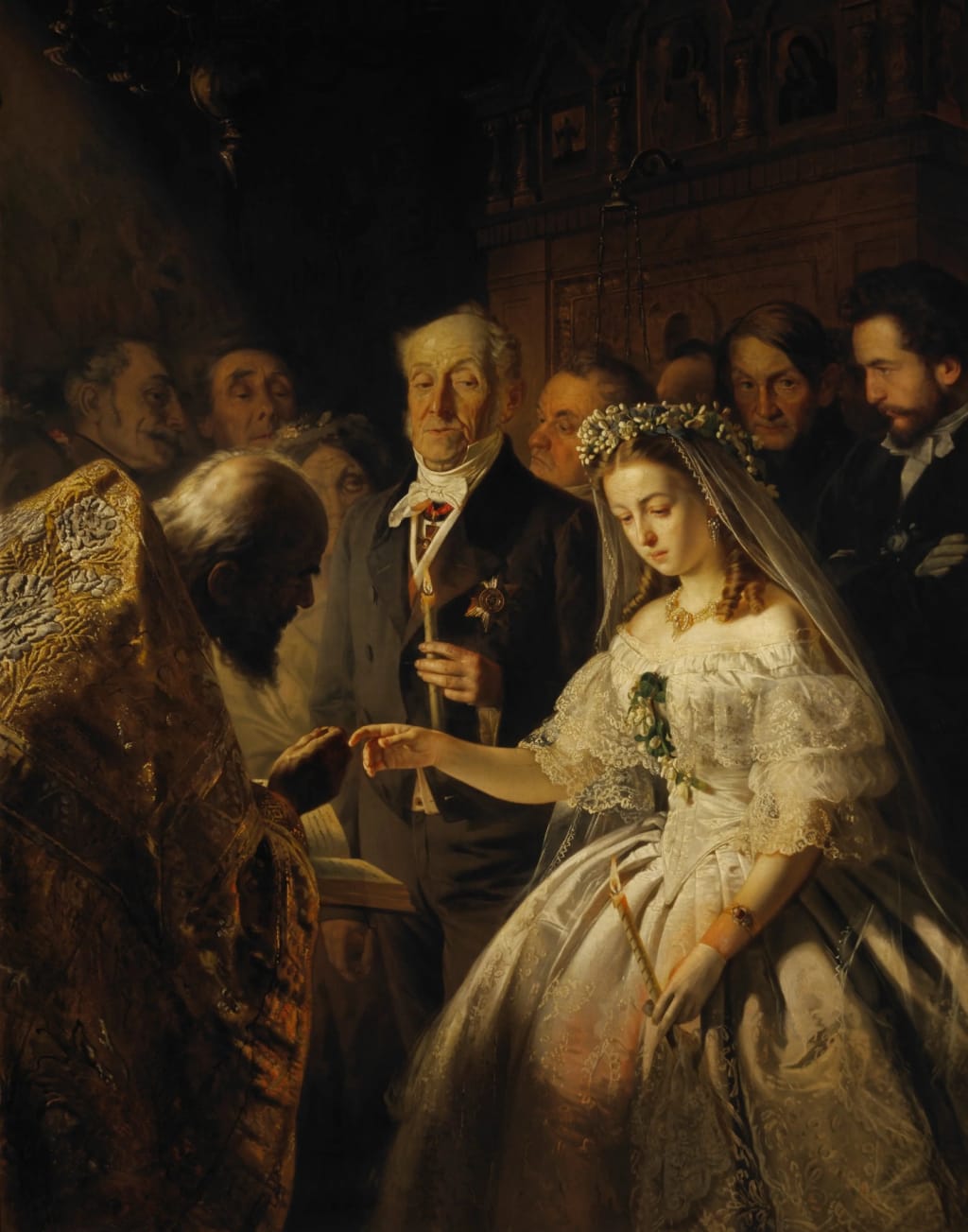
The Unequal Marriage (1862) by Vasili Vladimirovich Pukirev is a Realism work of art, which depicts the inequalities in marriage arrangements of the time. The painting depicts inequalities of age and wealth, as a young girl from an impoverished background is arranged to be married to a rich, old man. The painting was wildly praised for both it's skill and how it handled a controversial, yet important topic of older, affluent men taking younger women (sometimes children) as their next wife.
Even after more than a century of research and speculation, there are still a few unanswered details and interesting theories about the subject matters of this provocative piece.
Detail 1: Portrait of a Distressed Artist
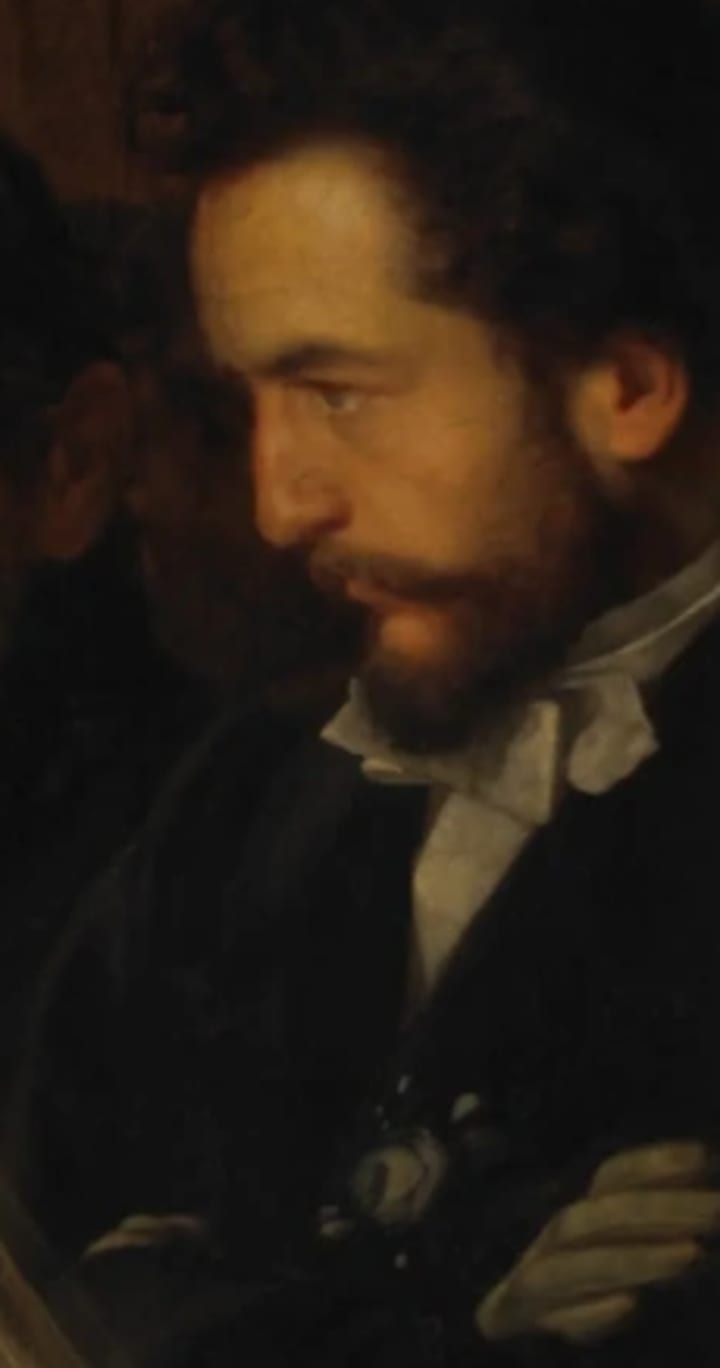
To the right of the bride, stands a man with a focused expression. And while uncovering the mysteries behind this painting, many viewers have attributed different emotions to this man. Some have suggested that this is the face of a man who loved the bride, and is now seeing her married away to a richer, older man. In a similar vein, others have noted that his gaze seems to be avoiding the bride, and instead speaks to a suppressed anger or jealousy towards the groom.
Another interesting belief is that this figure is intended to be a self-portrait of the artist himself. Considering the details in Pukirev's other portraits, this does seem plausible. However, it is unknown whether this scene was personal for Pukirev, or whether his self-insert was simply intended to depict his own distaste for marriages of child-brides to older, wealthy suitors.
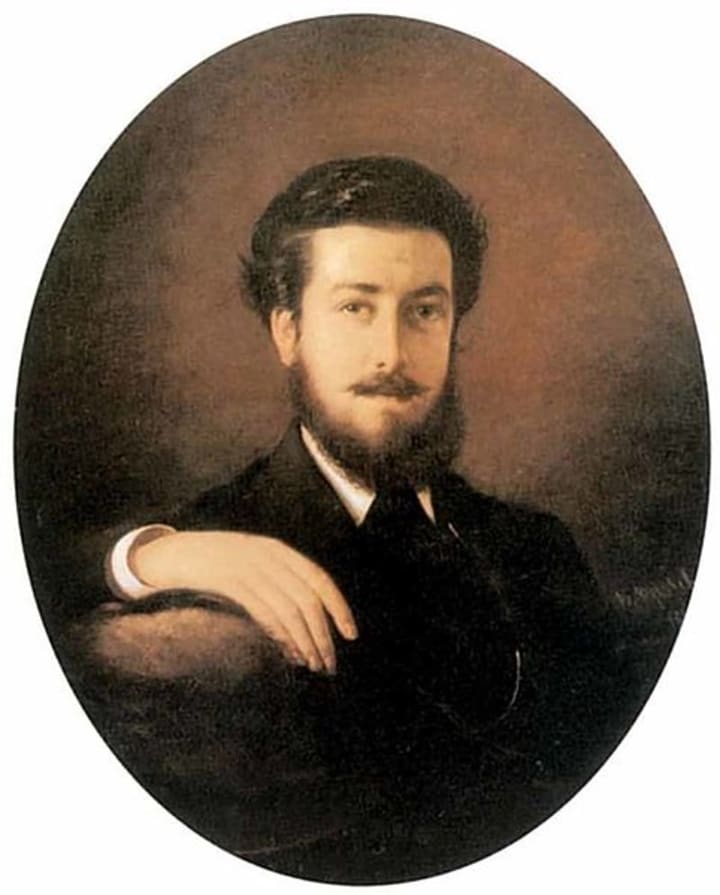
Detail 2: The Ghosts of Past Brides
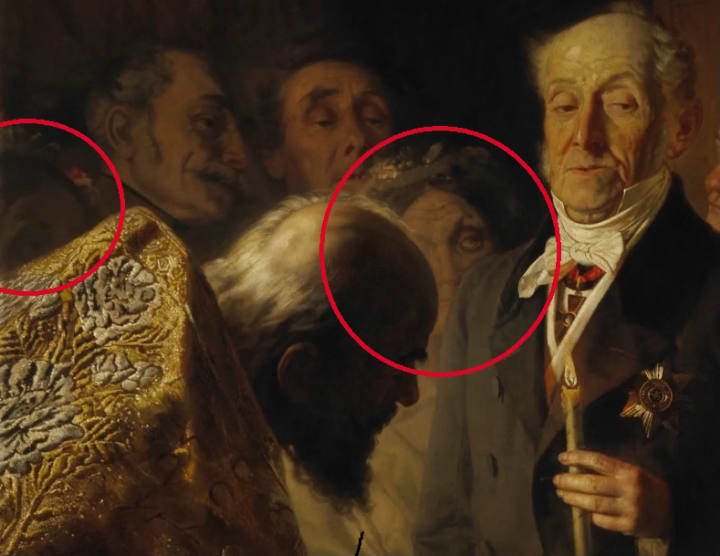
Another ominous detail of the painting is the two older women featured to the left of the groom (circled above in red). Both women have the same type of flower crowns traditionally worn by brides, and the woman closest to the groom can even been seen wearing a white dress.
The identity and nature of these women remain a mystery as well. A popular interpretation is that these two women are previous wives of this particular groom who look on in sadness, fear, or anger. Since the figures in the painting have never been identified, it is challenging to pinpoint the fate of these women. Did they die? Were they abandoned for this younger bride? Do they depict the misery and fate for the young girl who will soon take their place?
Detail 3: The Bride's Crown and Candle
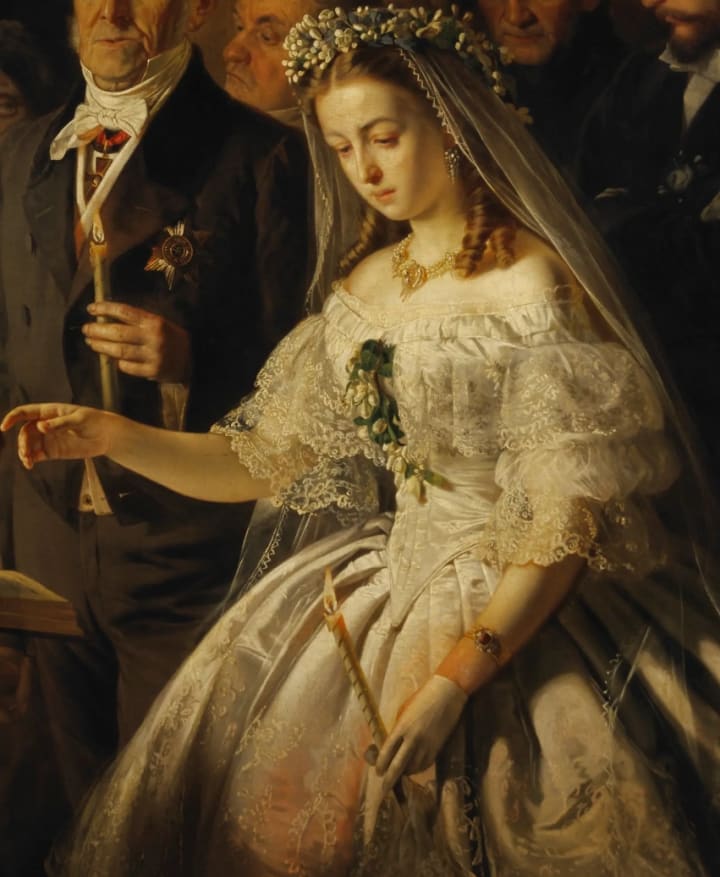
The central figure of the entire painting is the child - a young girl painted in delicate lace. The color palette chosen for her is soft and light, which contrasts the gloomy darkness around her. But what is most memorable about the bride is her face - her expression has been described as resigned, tearful, hopeless, and indifferent.
Unequal Marriage contrasts the age of the subjects in more ways than one - Vasili Pukirev adds subtle metaphors to enhance the storytelling of this image. One of which is the flower crown that adorns the brides head.
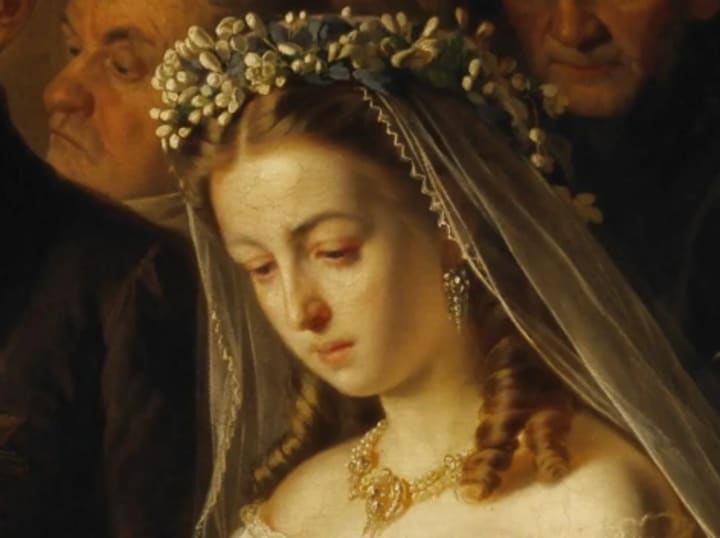
Here, you can see that none of the flowers on the crown have bloomed, and that the entire piece is made of flower buds. This crown is a metaphor for the girl herself, who is still a child, and has not been afforded the luxury of blossoming into a woman.
Another theory about the painting may be noticed in the way that she holds her ceremonial candle.
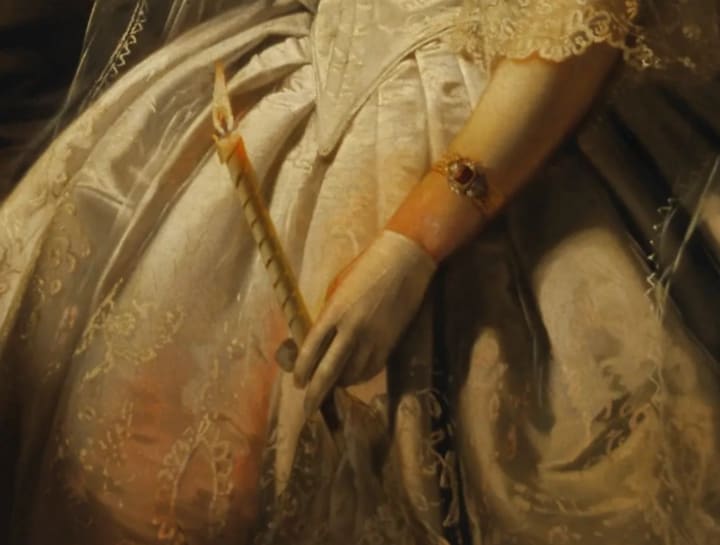
There is a lax grip, as the candle seems halfway to teetering from her hand. This could be interpreted as a simple reflection of the despair of the bride - but with a little more historical context, there is one more interpretation one could gather.
TW: Suicide
In the Victorian Era, there was a rise in crinoline cage dresses - a fashion that was intended to create voluminous hoop skirts with more comfort to the wearer. However, there became a disturbing side-effect to this fashion, as it was discovered that the crinoline dresses were extremely flammable, and dress fire accidents caused the death of over 3000 women. This phenomenon was well-documented, and eventually fire-proofing methods were developed - however, these methods tended not to be employed as much for fabrics that were supposed to be flowy and white, as the fire-proofing tended to yellow the gowns and make them still.
Since Unequal Marriage was painted in the era where dress fires were a present and known occurrence, some viewers have speculated that the young bride is debating setting her own dress on fire, as to die before she is doomed to marry the man before her.
Such a thing may have felt like the only way to escape.
~
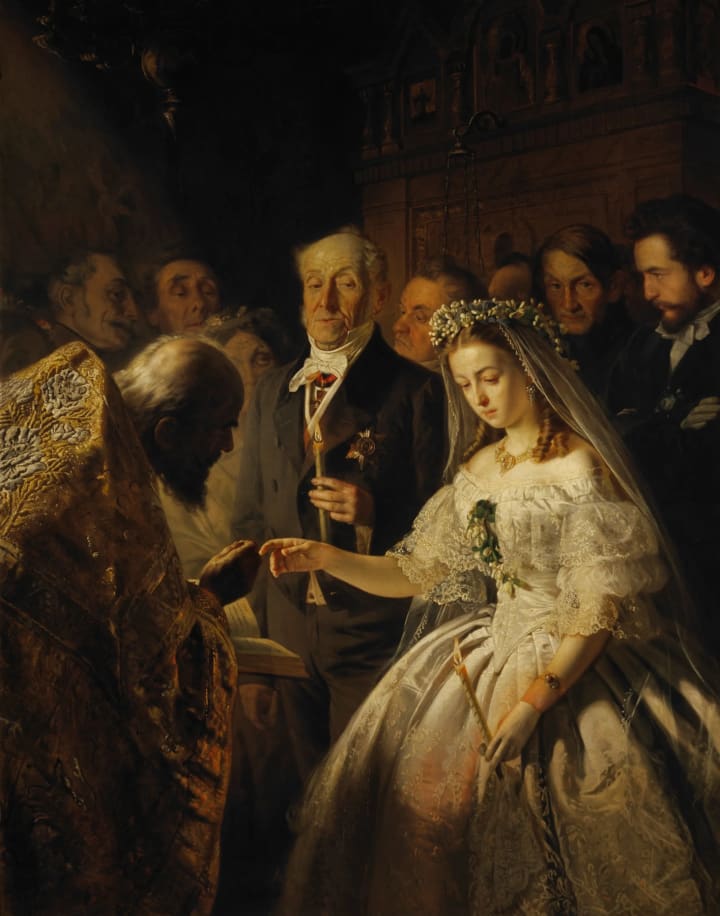
Acknowledgement and Sources:
Special thank you to Daily Art Magazine, Racked, and Art in Context, whose articles provided much of the information and analysis of this artwork. Also a thank you to Mae, whose video inspired me to research this subject and write about it.
Reader insights
Outstanding
Excellent work. Looking forward to reading more!
Top insights
Expert insights and opinions
Arguments were carefully researched and presented
Easy to read and follow
Well-structured & engaging content
Compelling and original writing
Creative use of language & vocab
Eye opening
Niche topic & fresh perspectives
On-point and relevant
Writing reflected the title & theme
Excellent storytelling
Original narrative & well developed characters
Masterful proofreading
Zero grammar & spelling mistakes



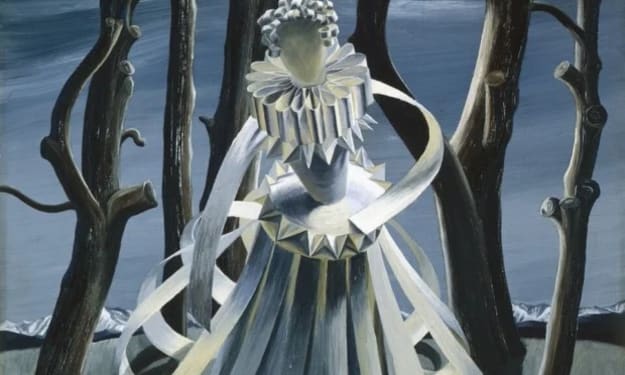
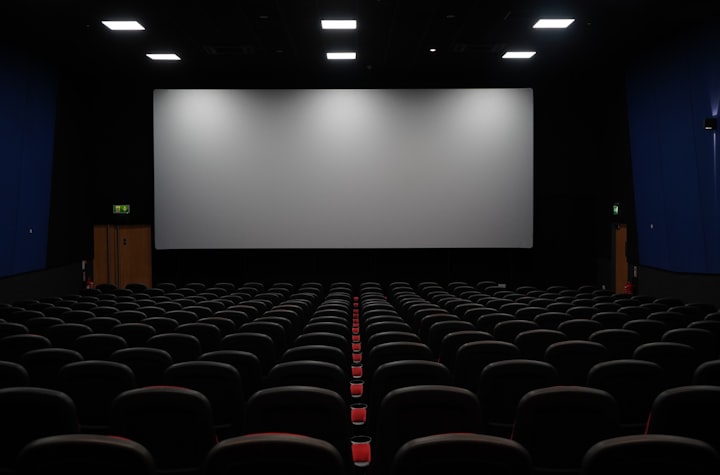


Comments (17)
New subscriber; congratulations on Top Story! I am an art lover truly longing to learn more in regards to art history.
Accept my warm congratulations on your top story!
btw your speculation was great only asking if you make it more detailed one with your own theory it will be appreciable and love your content
Congrats on Top Story!🥳
Hats off to your work! Keep it going—congrats!
That was so interesting! Thank you for analysis on such an interesting piece of artwork. Thank you for sharing this!
Excellent piece. I feel thoroughly educated on this topic! I sometimes see older men claim that wanting a younger wife is completely "natural" and was the norm historically. This is evidence that any taboo around old men marrying children isn't completely modern. People with sense and decency have always found it disgusting.
Your review is exceptional Briana! I love how you describe every detail. It gives me a deeper appreciation for the painting. I see emotion and sadness in the painting. I subscribed to you!!!
So fascinating! The stories, the metaphors, the layered emotions, and the secrets all within one painting really blow my mind. I'm definitely going to share this with the artists in my life. You did an excellent exploration here, thank you.
Interesting analysis. So sad. What a life immortalised by art.
Thank you for this, really interesting!
I found this piece very interesting. When I first looked at this painting, I thought, "This girl is about to drop that candle." I didn't know about the dress fires until I read what you wrote so I have to agree with your analysis. Congratulations on your well-deserved top story!!!
Very detailed article with an intriguing, controversial topic. Congrats! 🎊
Bri, thank you for posting this! I thoroughly enjoyed reading your thoughts on this art and page in history.
Awesome critique!!! Loved it!!!♥️♥️💕
Huh, never knew that
Wonderful article full of insight. Interpreting historical paintings is a fascinating subject and you have really brought life to the subject.